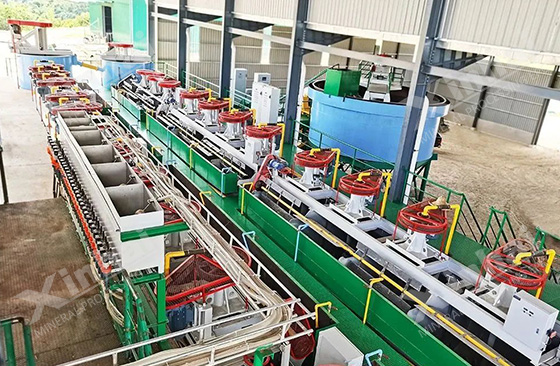
Zinc metal is widely used in industry and occupies an important position in the national economy. Its dosage is similar to that of copper, lead, etc. Zinc oxide is an important mineral resource of zinc. There are many types of zinc oxide ores in nature, which are half-doped with each other, have finer particle size, and are in a serious muddy state. Because of these characteristics, the difficulty of mineral processing and the loss of fine-grained zinc oxide increases, the recovery rate and enrichment ratio of the concentrate are low. The methods commonly used to treat zinc oxide mainly include fire method, wet method and flotation method, among which flotation method is the most widely used technology. The following will introduce you to the flotation process of zinc oxide.
The most commonly used zinc oxide beneficiation process is flotation, which can be mainly divided into sulfide-amine method, heated sulfide xanthate method, fatty acid direct flotation method, chelate flotation method and other flotation methods. The most effective of the above flotation methods is the ammonium sulfide salt flotation method. After the zinc oxide ore is heated and sulfurized, the sulfide xanthate method requires the addition of an activator before flotation, and consumes a large amount of reagents, so it is rarely used in industry. Fatty acid collectors have poor selectivity for most ores and have few industrial applications.
.jpg)
This flotation method is to sulfide zinc oxide minerals with sodium sulfide and then float them using fatty amines as collectors. It has become the main method of zinc oxide flotation and is widely used in mineral processing plants. The sulfide-amine method generally does not require heating and sulfurization and can be carried out under normal temperature conditions. Excessive sodium sulfide has no obvious inhibitory effect. The use of amine collectors has good selectivity and can effectively recover zinc oxide minerals. The beneficiation index of this method is better than that of the sulfide-xanthate method. However, this flotation method also has some shortcomings, such as being sensitive to slime and soluble salts and consuming large amounts of chemicals. Therefore, in order to achieve a higher concentrate grade, it is necessary to deslim in advance, but this will result in the loss of a large amount of zinc metal. Another example is that it is not suitable to process ores containing a large amount of mica, sericite, chlorite, shale and other minerals, because these gangue minerals will float together with zinc oxide during the flotation process, which will seriously affect the quality of the concentrate. This method The collection ability of hemimorphite is weak, but it cannot collect iron smithsonite.
.jpg)
Many research results at home and abroad show that zinc oxide minerals, like lead oxide minerals, can be recovered by xanthate flotation after sulfurization. But one thing is different from lead oxide. Zinc oxide minerals need to be activated by copper sulfate after sulfidation before they can be flotated. It can be seen from the above that the sulfide xanthate method has some shortcomings, such as the need to remove -10 micron sludge, and the process is unstable; the treatment effect is poor for ores containing a large amount of iron oxide; the recovery rate of zinc silicate minerals is low; Adding excess sodium sulfide has a significant inhibitory effect on the flotation of zinc oxide, and heating and sulfurization is required.
.jpg)
Fatty acid collectors can directly flotate zinc oxide or can be used for reverse flotation. They have better flotation effects on siliceous and argillaceous gangue minerals, but are very difficult to use on carbonate gangue minerals, especially It is more difficult for zinc oxide ores with high iron content. When processing zinc oxide ore containing a considerable amount of carbonate and sulfate gangue minerals, oleic acid is used as a collector, and the zinc oxide rough concentrate containing carbonate gangue minerals is treated with sodium sulfide and soda , reverse flotation of gangue minerals to obtain high-quality zinc concentrate. This process does not require removal of chemicals, but has poor selectivity and is not widely used in industry. It is mainly used for mixed flotation of refractory sulfide-oxidized polymetallic ores.
.jpg)
Chelating collector is an excellent collector with high selectivity and strong ability to collect zinc oxide ore. Although chelating collectors have good effects, chelating agents have the disadvantage of being expensive. When used as collectors alone, a large amount is required, so they are rarely used in actual production.
When flotating zinc oxide, adding flocculants such as caustic starch to flocculate fine mud can increase the particle size of zinc oxide slime by 2-10 times and increase its floatability. The flocculation method can reduce desliming operations, reduce the loss of zinc metal, and significantly reduce the dosage of sodium sulfide. The key to zinc oxide flocculation and flotation is to choose the correct flocculant with high selectivity for zinc oxide.

The above is a brief introduction to several zinc oxide flotation process methods. The more difficult part of zinc oxide sorting is the separation of fine-grained zinc oxide minerals and gangue minerals. In order to choose a suitable zinc oxide separation method, it is necessary to conduct mineral processing tests and analysis of ores. Xinhai Mining can provide you with mineral processing tests of copper-lead-zinc ores and other polymetallic ores, the design of mineral processing plans and the production and manufacturing of equipment to help you improve concentrate recovery rate and mineral processing indicators.
To find out more about our products and solutions, please fill out the form below and one of our experts will get back to you shortly.